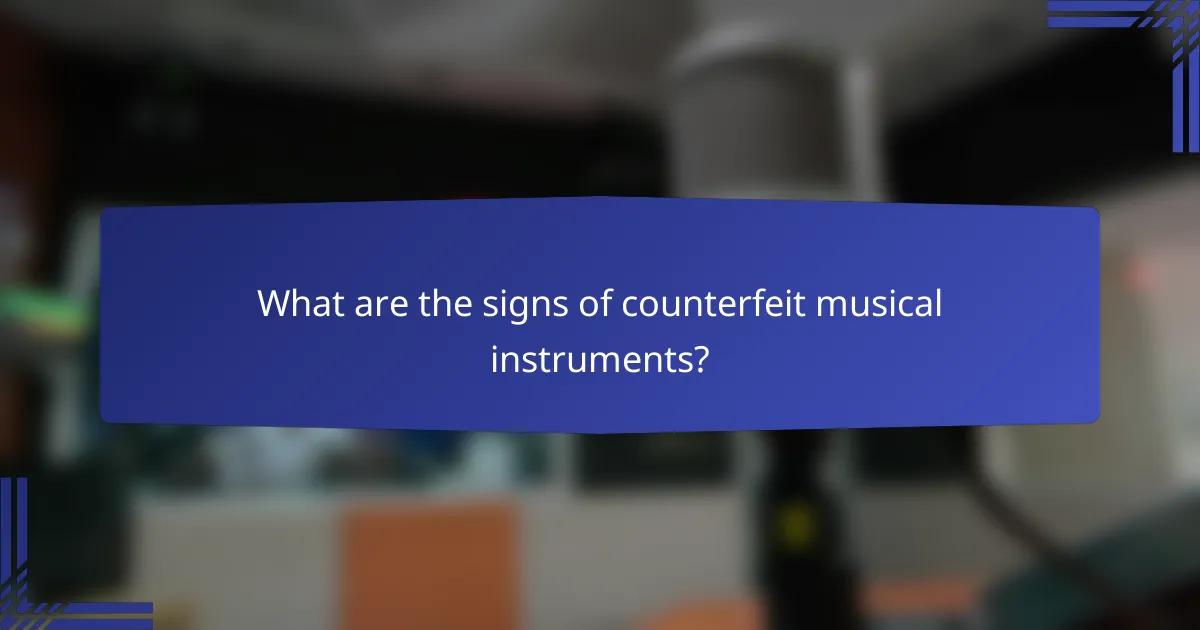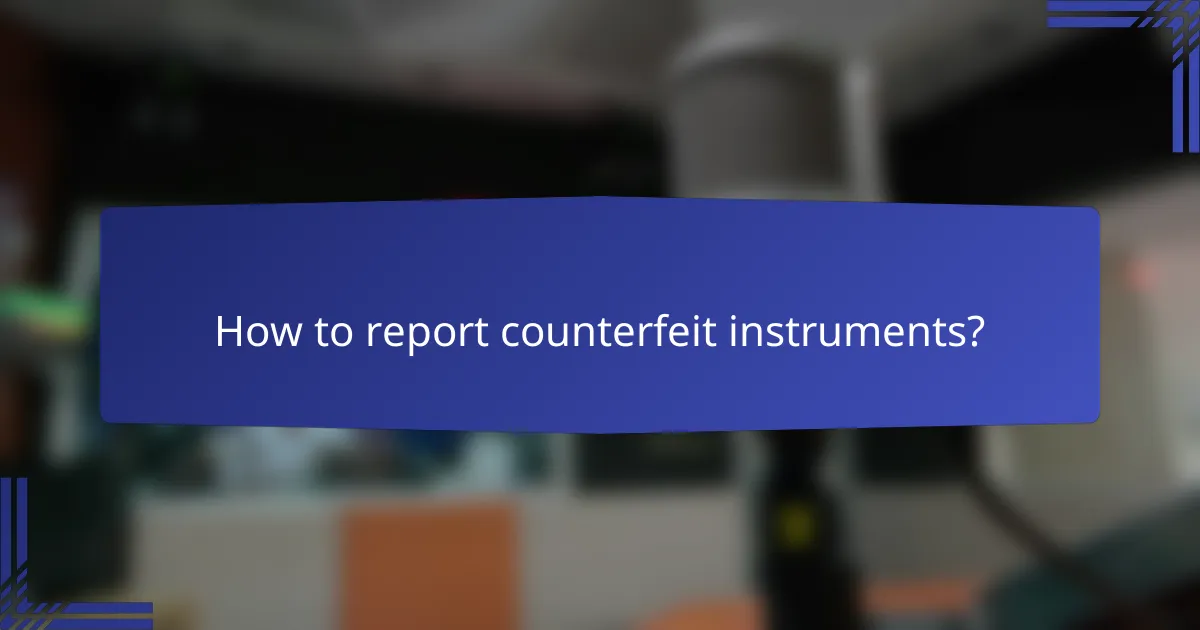In the world of musical instruments, distinguishing between authentic and fake products is crucial for both performance and investment. Identifying fake instruments requires careful visual checks, sound evaluations, and brand verification to avoid the risks associated with counterfeit purchases. Buyers should prioritize reputable sources and certifications to ensure they acquire genuine instruments that meet their expectations and legal standards.

How to identify fake instruments?
Identifying fake instruments involves a combination of visual checks, sound evaluations, material assessments, and brand verification. Each method provides critical insights that can help distinguish genuine instruments from counterfeits.
Visual inspection techniques
Start by examining the instrument’s overall appearance for inconsistencies in design, logos, and craftsmanship. Look for irregularities such as uneven seams, poor paint jobs, or misspelled brand names, which are common in counterfeit items.
Use a magnifying glass to inspect details like serial numbers and labels. Authentic instruments often have precise engravings, while fakes may have rough or poorly executed markings.
Sound quality assessment
Evaluate the instrument’s sound quality by playing it in various styles and techniques. Genuine instruments typically produce a rich, full sound, while fakes may sound thin or lack resonance.
Consider recording the sound and comparing it to known authentic models. If possible, test the instrument alongside similar authentic ones to identify any significant differences in tone and clarity.
Material analysis
Assess the materials used in the instrument’s construction. Authentic instruments often utilize high-quality woods, metals, or plastics, while fakes may use cheaper alternatives that affect durability and sound quality.
For string instruments, check the strings and fittings for quality. For brass or woodwind instruments, examine the finish and any pads or valves for signs of inferior materials.
Brand authenticity verification
Research the brand’s official website for information on how to verify authenticity. Many reputable brands provide guidelines on identifying genuine products, including details on serial numbers and authorized dealers.
Consider contacting the manufacturer directly with the instrument’s details for confirmation. If purchasing from a third party, ensure they provide a receipt or proof of purchase from an authorized dealer.

What are the risks of purchasing fake instruments?
Purchasing fake instruments carries significant risks, including financial loss, legal issues, and negative impacts on musical performance. Buyers may find themselves with subpar products that do not meet their expectations or legal standards.
Financial loss
Investing in counterfeit instruments can lead to substantial financial loss. Authentic instruments often hold their value, while fakes can depreciate rapidly, leaving buyers with little to no resale value. It’s crucial to research prices and verify authenticity before making a purchase.
For instance, a genuine guitar might cost several hundred to thousands of dollars, while a fake could be priced similarly but lacks quality. Always compare prices from reputable sources to avoid overpaying for a counterfeit.
Legal implications
Buying fake instruments may expose buyers to legal consequences, including potential lawsuits for copyright infringement. Many countries have strict laws against the sale and distribution of counterfeit goods, which can result in fines or other penalties.
Additionally, if a buyer unknowingly purchases a fake, they could face difficulties if they attempt to sell it later. It’s advisable to obtain documentation or certificates of authenticity to protect oneself legally.
Impact on musical performance
Fake instruments often fail to deliver the same sound quality and playability as authentic ones, negatively affecting musical performance. Musicians may struggle with tuning issues, poor craftsmanship, and unreliable materials, which can hinder their ability to perform effectively.
For example, a counterfeit violin may not produce the rich tones expected from a quality instrument, impacting a musician’s practice and performance. Investing in genuine instruments ensures better sound quality and overall satisfaction in musical endeavors.

How to buy authentic instruments in the UK?
To buy authentic instruments in the UK, focus on purchasing from reputable sources, checking for certifications, and utilizing buyer protection features when shopping online. These steps help ensure you receive genuine products and avoid counterfeit instruments.
Reputable retailers
Buying from well-known music stores or authorized dealers is crucial for ensuring authenticity. Retailers with a solid reputation often have established relationships with manufacturers and can provide verified products. Look for shops that have been in business for several years and have positive customer reviews.
Additionally, consider visiting local music shops where you can physically inspect the instrument before purchase. This allows you to assess the quality and craftsmanship directly, reducing the risk of buying a fake.
Online marketplaces with buyer protection
When shopping online, choose marketplaces that offer buyer protection policies, such as eBay or Reverb. These platforms often have measures in place to resolve disputes and refund buyers if an item is not as described. Always read the terms of service to understand the protections available.
Before completing a purchase, check seller ratings and reviews. A high rating and positive feedback from previous buyers can indicate a trustworthy seller, while a lack of reviews or numerous complaints may signal potential issues.
Manufacturer certifications
Many authentic instruments come with manufacturer certifications or documentation that verify their authenticity. Look for certificates of authenticity or warranty cards that accompany the instrument. These documents often include serial numbers that can be cross-referenced with the manufacturer.
Additionally, familiarize yourself with the specific certification standards for the type of instrument you are purchasing. For example, high-end guitars may have specific quality marks that indicate they meet certain craftsmanship standards. Always verify these details before finalizing your purchase.

What are the signs of counterfeit musical instruments?
Counterfeit musical instruments often exhibit specific signs that can help buyers identify them. Recognizing these signs, such as poor craftsmanship, inconsistent branding, and unusual pricing, is crucial for making informed purchasing decisions.
Poor craftsmanship
One of the most telling signs of a counterfeit musical instrument is poor craftsmanship. This can include uneven finishes, poorly aligned parts, and substandard materials that do not meet the quality of genuine products. For example, a legitimate guitar will have smooth frets and a polished body, while a fake may show rough edges and visible glue marks.
When inspecting an instrument, look for details like the quality of the hardware and the overall assembly. If the instrument feels flimsy or lacks the weight typical of authentic models, it may be a counterfeit.
Inconsistent branding
Inconsistent branding is another red flag when identifying counterfeit musical instruments. Check for discrepancies in logos, model numbers, and serial numbers. Authentic brands have specific branding guidelines, and any deviation can indicate a fake.
For instance, if a brand’s logo appears in a different font or color than usual, or if the serial number does not match the manufacturer’s records, it’s wise to be cautious. Always verify the branding against official sources or the manufacturer’s website.
Unusual pricing
Unusual pricing can be a significant indicator of counterfeit musical instruments. If a deal seems too good to be true, it probably is. Genuine instruments typically have a price range that reflects their quality and brand reputation, so prices that are significantly lower than market value should raise suspicion.
When evaluating a price, compare it with similar models from reputable retailers. If you find a similar instrument priced at a fraction of the average cost, consider it a warning sign and investigate further before making a purchase.

How to report counterfeit instruments?
To report counterfeit instruments, contact the relevant authorities or the manufacturer directly. Prompt reporting helps prevent further distribution and protects other consumers.
Contacting manufacturers
Reach out to the manufacturer of the instrument if you suspect it is counterfeit. Most manufacturers have dedicated channels for reporting counterfeit products, which may include customer service hotlines or online forms.
When contacting a manufacturer, provide detailed information about the instrument, including model numbers, purchase details, and any suspicious characteristics. This information can assist them in verifying authenticity and taking appropriate action.
Keep records of your communications with the manufacturer, as this may be useful if further action is required, such as filing a complaint with consumer protection agencies.
